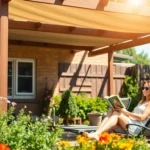We’ve all walked past those wooden pallets stacked behind stores and wondered if there’s more to their story. These humble shipping materials are actually treasure troves waiting to transform your outdoor space into something extraordinary. With just a few simple tools and some creativity you can turn discarded pallets into stunning garden features that’ll make your neighbors stop and stare.
Pallet gardening isn’t just about saving money – though we love that it costs practically nothing to get started. It’s about creating sustainable beautiful spaces that showcase your plants in unique ways. From vertical herb walls to rustic planters these versatile wooden frames offer endless possibilities for every gardening style and skill level.
Whether you’re working with a tiny balcony or a sprawling backyard we’ll show you how to unlock the potential hiding in plain sight. Get ready to discover why pallet gardens are taking over Pinterest boards and transforming ordinary yards into Instagram-worthy outdoor sanctuaries.
Vertical Pallet Garden Walls for Small Spaces
Maximizing limited outdoor space becomes effortless when we use vertical pallet garden walls. These space-saving answers transform bare walls into lush growing environments that produce fresh herbs and showcase beautiful plants.
Creating Herb Gardens on Walls
Selecting the right herbs for vertical pallet gardens ensures year-round harvests in compact spaces. Mediterranean herbs like rosemary, thyme, and oregano thrive in pallet pockets because they prefer well-draining conditions. We position cooking essentials such as basil, parsley, and cilantro at eye level for easy harvesting during meal preparation.
Preparing pallet pockets requires exact soil amendments to support healthy herb growth. We fill each planting space with a lightweight potting mix containing perlite and compost to prevent waterlogging. Adding slow-release fertilizer pellets every three months keeps herbs producing fresh leaves throughout the growing season.
Arranging herbs by growth patterns maximizes space efficiency and visual appeal. Trailing varieties like creeping thyme work perfectly in bottom pockets where they can cascade downward. We place upright growers such as sage and lavender in middle sections to create natural height variation.
Building Succulent Display Walls
Choosing drought-tolerant succulents creates stunning vertical displays that require minimal maintenance. Hardy varieties like sedum, echeveria, and jade plants establish quickly in pallet environments because they adapt to shallow root spaces. We combine different textures and colors such as purple aeonium with silver ghost plants to create visual interest.
Installing proper drainage prevents root rot and extends succulent lifespan in vertical gardens. We drill additional drainage holes in pallet slats and add a layer of gravel before filling with cactus potting mix. This drainage system allows excess water to flow freely while maintaining the moisture balance succulents need.
Creating seasonal color schemes keeps vertical succulent walls attractive throughout the year. Cold-hardy options like hens and chicks provide green structure during winter months. We incorporate flowering varieties such as kalanchoe and christmas cactus to add seasonal blooms that complement the permanent plantings.
Installing Irrigation Systems for Vertical Gardens
Setting up drip irrigation systems ensures consistent watering for vertical pallet gardens without daily maintenance. We install a main water line along the top edge of the pallet and connect individual drip emitters to each planting pocket. This automated system delivers precise amounts of water directly to root zones while preventing waste.
Programming timer controls optimizes watering schedules based on plant needs and weather conditions. Most herbs require watering every 2-3 days during growing season, while succulents need water only once weekly. We adjust timer settings seasonally to account for temperature changes and rainfall patterns.
Installing overflow collection systems prevents water damage to walls and surrounding areas. We position removable drip trays beneath vertical gardens to catch excess water that flows through drainage holes. These collection systems allow us to monitor water usage and redirect captured water to other garden areas.
Raised Garden Beds Using Pallet Frames

Pallet frames transform traditional gardening by creating structured growing spaces that maximize both efficiency and aesthetics. We’ll explore three essential approaches to building these versatile garden beds.
Constructing Single-Level Raised Beds
Single-level beds offer the perfect starting point for pallet gardening enthusiasts. We recommend standard dimensions of 3×3 feet or 3×6 feet, adjusting based on your available space and desired plant density.
Start by collecting heat-treated pallets to ensure safe growing conditions for your plants. Cut the pallet boards into desired lengths using a saw, focusing on creating uniform pieces for the sides and bottom of your bed. Assemble the frame by nailing or screwing the boards together, ensuring each connection is secure and properly aligned.
Position the bottom section directly on the ground, then attach the side panels around it. Add corner posts made from thicker pallet boards or 2x4s for enhanced stability, especially for larger bed configurations. Support posts along longer sides prevent bowing and maintain the bed’s structural integrity throughout growing seasons.
Building Multi-Tiered Garden Boxes
Multi-tiered designs create stunning visual displays while maximizing growing space in compact areas. Each tier functions as a separate raised bed, with upper levels slightly smaller than lower ones to create an appealing stepped appearance.
Build each individual tier following single-level construction methods, ensuring proper measurements for your stacked design. Stack the completed tiers carefully, adding supports between each level to prevent shifting or structural instability. Consider the weight distribution when planning your multi-tier layout, as soil and water add considerable mass to each section.
Position larger plants in lower tiers and smaller varieties in upper sections for optimal light distribution. Access pathways between tiers allow for easy maintenance and harvesting of your tiered garden system.
Adding Drainage and Soil Preparation
Proper drainage prevents root rot and ensures healthy plant development in pallet garden beds. Drill drainage holes throughout the bottom of each bed, spacing them approximately 6 inches apart for adequate water flow.
Create an optimal growing medium by mixing topsoil, compost, and perlite or sand in equal proportions. This combination provides excellent drainage while retaining necessary moisture and nutrients for plant growth. Fill beds gradually, allowing the soil mixture to settle naturally before adding the final layer.
Monitor soil levels regularly, as settling occurs naturally over time and may require additional soil additions. Water thoroughly after initial filling to identify any drainage issues that need addressing before planting begins.
Pallet Planters for Container Gardening

Container gardening becomes even more exciting when we repurpose pallets into functional planters. These versatile wooden structures offer endless possibilities for creating unique growing spaces that fit any garden style or size limitation.
Making Portable Herb Planters
Creating portable herb planters from pallets transforms vertical space into a productive growing area. We position the pallet upright against a wall or fence and secure it properly to prevent tipping. Individual herb pots slide perfectly onto each horizontal slat, creating natural shelving that’s both functional and attractive.
Selection of herbs works best when we choose compact varieties like basil, oregano, thyme, and parsley that thrive in containers. Each pot maintains its own root system and watering schedule, making plant care more manageable than traditional garden beds. Moving individual pots allows us to rearrange the display seasonally or relocate tender herbs indoors during cold weather.
Organizing the herb display creates visual appeal while maximizing growing potential. We place taller herbs like rosemary on upper shelves and trailing varieties like oregano on lower levels. Grouping herbs by water requirements ensures efficient care routines and prevents overwatering sensitive plants.
Creating Decorative Flower Boxes
Building decorative flower boxes from pallet wood combines rustic charm with practical growing space. We disassemble pallets carefully to preserve the weathered wood character that adds instant vintage appeal to any garden setting. Individual planks become the sides and ends of rectangular planters that accommodate various flower types.
Adding a solid bottom prevents soil spillage and creates proper drainage when we drill holes every 6 inches across the base. Industry fabric lines the interior to retain soil while allowing water to escape freely. Standard flower box dimensions of 24 inches long by 8 inches wide provide adequate root space for most annual flowers.
Decorating the finished boxes enhances their garden appeal without compromising the rustic aesthetic. We apply weatherproof stain in natural tones or leave the wood untreated for authentic aging. Metal corner brackets reinforce joints and add industrial charm that complements the reclaimed wood appearance.
Building Self-Watering Pallet Containers
Constructing self-watering containers from pallets reduces maintenance while ensuring consistent plant hydration. We create a water reservoir system by installing a sealed bottom compartment that holds water for gradual plant uptake. This method works particularly well for vegetables and herbs that require steady moisture levels.
Layering the container properly ensures effective water distribution throughout the growing medium. We place a perforated barrier above the water reservoir, followed by a wicking layer of coconut coir or similar material. Quality potting soil fills the remaining space, creating optimal growing conditions for plant roots.
Installing the watering system involves adding a fill tube that extends from the reservoir to the soil surface. We monitor water levels through a viewing tube and refill as needed, typically every 7 to 10 days depending on plant size and weather conditions. This system maintains consistent soil moisture without the risk of overwatering that often affects traditional container gardens.
Garden Furniture Projects with Recycled Pallets

Building functional furniture from pallets extends your gardening workspace while maintaining the sustainable theme of your outdoor paradise. These rustic pieces add character to any garden while providing practical answers for storage and workspace needs.
Constructing Garden Benches and Seating
Creating comfortable seating areas starts with disassembling pallets carefully to preserve the best wood pieces. We recommend selecting pallets with minimal gaps between slats for better back support and comfort. Sand all surfaces thoroughly to prevent splinters and apply weather-resistant stain or sealant for longevity.
Position two pallets vertically as the bench frame and secure them with wood screws or metal brackets. Add a third pallet horizontally on top to create the seat surface, ensuring all connections are tight and stable. Consider adding cushions or outdoor fabric covers to enhance comfort during long gardening sessions.
Stackable pallet benches offer versatility for different garden events and seasonal changes. Design modular seating units that can be rearranged for garden parties or moved closer to exact work areas when needed. Paint or stain these pieces in coordinating colors to create a cohesive outdoor furniture collection.
Building Potting Tables and Work Stations
Constructing a potting table requires stacking pallets vertically and adding a sturdy wooden top surface. We suggest using reclaimed wood planks or plywood sheets cut to size for the work surface. This elevated workspace provides ample room for potting plants while keeping tools and supplies organized at comfortable working height.
Install hooks and small shelving compartments on the vertical pallet sections for enhanced functionality. Attach mason jars or small containers to hold seeds, plant ties, and other gardening accessories. Consider adding a lower shelf between the pallet legs for storing larger items like bags of soil or fertilizer.
Mobile potting stations become possible by adding caster wheels to the bottom corners of your pallet construction. Choose heavy-duty outdoor wheels that can handle uneven garden surfaces and lock in place when working. This mobility allows you to move your workspace closer to different garden areas as needed throughout the growing season.
Creating Storage Answers for Garden Tools
Transforming pallets into tool storage begins with mounting them vertically against garden walls or fence posts. We attach various hooks, brackets, and holders directly to the pallet slats to accommodate different tool sizes and shapes. Long-handled tools like rakes and hoes fit perfectly in the wider gaps between boards.
Custom compartments can be added by installing small boxes or containers between pallet slats for smaller items. Create designated spaces for hand tools, gloves, seed packets, and plant labels using repurposed containers or purpose-built wooden boxes. Label each section clearly to maintain organization throughout busy gardening seasons.
Weather protection becomes essential for outdoor pallet storage answers through proper sealing and positioning. Apply multiple coats of exterior wood stain or paint to prevent moisture damage and wood rot. Position storage units under eaves or covered areas when possible, or add a simple roof overhang to protect stored tools and supplies from rain and direct sunlight.
Creative Pallet Pathways and Garden Borders

We’re transforming our garden accessibility and visual appeal with pallet pathways and borders that combine functionality with rustic charm. These wooden walkways and decorative edges create defined spaces while adding sustainable elements to our outdoor design.
Installing Rustic Wooden Walkways
Disassembling pallets for pathway construction creates the foundation for our rustic wooden walkways. We carefully remove planks from pallets using a pry bar and hammer, preserving the natural wood grain and character that gives these pathways their distinctive appeal.
Arranging pallet planks flat on the ground forms the base structure of our walkway design. We position the wooden slats in parallel lines or alternating patterns, creating visual interest while ensuring stable foot traffic flow through garden areas.
Securing walkway planks with screws and nails provides long lasting durability for high traffic zones. We use exterior grade fasteners spaced every 12 inches along the planks, preventing movement and maintaining structural integrity throughout seasonal weather changes.
Leveling the ground beneath pallet pathways ensures consistent walking surfaces and proper drainage. We excavate 2 to 3 inches of soil along the pathway route, adding a layer of sand or gravel to create a stable foundation that prevents wood from direct ground contact.
Building Decorative Garden Edging
Positioning pallets upright around garden beds creates instant decorative borders that define planting areas. We place full pallets vertically along garden perimeters, allowing the natural slat spacing to provide visual texture while containing soil and mulch within designated growing zones.
Creating flexible edging with individual pallet slats offers customizable border answers for curved or irregularly shaped garden beds. We disassemble pallets into separate planks, arranging them at varying heights to follow natural industry contours and create ever-changing visual lines.
Stacking pallets vertically for space saving borders maximizes our garden’s vertical dimension while conserving ground space. We secure multiple pallets in tower formations using metal brackets, creating dramatic height differences that add depth and architectural interest to flat garden areas.
Installing pallet edging with proper spacing allows for plant growth while maintaining clean border definition. We position slats with 6 to 8 inch gaps between sections, providing adequate soil drainage and root expansion space for plants growing along the border edges.
Constructing Stepping Stone Alternatives
Cutting pallets into stepping stone squares provides eco friendly pathway elements that blend naturally with garden environments. We use a circular saw to create 18 inch by 18 inch sections from pallet wood, sanding the surfaces smooth to prevent splinters while maintaining the rustic wood texture.
Arranging pallet stepping stones with consistent spacing creates comfortable walking rhythm through garden pathways. We position each wooden square 24 inches apart, measuring center to center distances that accommodate natural walking stride patterns for easy garden navigation.
Using pallet wood as pathway fillers creates cohesive design between traditional stepping stones and wooden elements. We cut smaller pallet pieces to fit gaps between existing stone or concrete pavers, adding organic texture that softens hard industry materials.
Treating pallet stepping stones for weather resistance extends the lifespan of our wooden pathway elements. We apply exterior wood stain or sealant to all surfaces, focusing on cut edges where moisture penetration typically begins, ensuring our stepping stone alternatives withstand seasonal weather conditions.
Pallet Composting Systems and Storage

Transform your garden organization with practical pallet storage answers that extend beyond planting. These versatile wooden structures create efficient systems for composting and storing essential garden materials.
Building Three-Bin Compost Systems
Three-bin compost systems using pallets provide the most efficient way to manage organic waste throughout different decomposition stages. Position three pallets vertically in a U-shape configuration to create separate compartments for fresh materials, active composting, and finished compost. Secure the pallets together using heavy-duty hinges on one side of each dividing wall, allowing easy access for turning and harvesting compost.
Fresh material goes into the first bin where we add kitchen scraps and yard waste. Green materials like vegetable peels and grass clippings combine with brown materials such as dried leaves and small branches. This initial stage requires regular mixing to promote proper air circulation.
Active composting happens in the middle bin where materials break down over several months. Turn the contents every few weeks using a pitchfork to maintain proper moisture and oxygen levels. The decomposition process generates heat, indicating healthy microbial activity.
Finished compost develops in the third bin where dark, crumbly soil amendment awaits garden use. This completed compost typically takes 6-12 months to develop and provides nutrient-rich material for all garden projects.
Creating Tool and Supply Storage Units
Tool storage units made from pallets keep gardening equipment organized and easily accessible. Attach additional pallet slats horizontally between vertical supports to create custom shelving for different tool sizes. Mount hooks along the vertical supports to hang long-handled tools like shovels, rakes, and hoses.
Supply organization becomes effortless with designated compartments for seeds, fertilizers, and small tools. Install removable bins or baskets between pallet slats to store packets of seeds, garden gloves, and hand tools. Label each section clearly to maintain organization throughout the growing season.
Weather protection extends tool life when storage units include roof coverage. Add a slanted roof using additional pallet boards or corrugated metal sheeting to protect tools from rain and snow. Apply weatherproof stain or paint to all wooden surfaces for enhanced durability.
Constructing Firewood and Mulch Storage
Firewood storage using pallets creates ventilated structures that keep wood dry and properly seasoned. Stack pallets horizontally to form the base, preventing ground moisture from reaching the firewood. Build sidewalls using vertical pallets to contain the wood while allowing air circulation.
Mulch storage compartments organize different types of organic materials for garden use. Create separate sections for bark mulch, wood chips, and shredded leaves using pallet dividers. This organization system makes it easy to access the right type of mulch for exact garden areas.
Proper ventilation prevents moisture buildup and material degradation in storage areas. Leave gaps between pallet slats to promote air flow through stored materials. Position storage units away from buildings and trees to maximize air circulation and prevent pest problems.
Decorative Garden Features Using Pallets

Pallets transform into stunning decorative elements that elevate our garden’s visual appeal while serving practical purposes. These versatile wooden structures offer endless possibilities for creating unique features that blend functionality with rustic charm.
Making Garden Trellises and Climbing Supports
Vertical trellis construction becomes simple when we disassemble pallets and repurpose the individual slats for climbing plant supports. We can attach these weathered wooden pieces to two sturdy posts, creating an instant framework for peas, beans, and flowering vines. The natural spacing between pallet slats provides perfect gaps for plant tendrils to weave through and establish strong holds.
Complex arbors and archways emerge when we secure multiple pallets together using galvanized screws or heavy duty wire connections. These larger structures frame garden entrances beautifully while supporting heavier climbing plants like roses or grape vines. Strategic positioning of these pallet arbors creates natural garden rooms that define different growing areas.
Modular trellis systems allow us to expand our climbing support network as our garden grows throughout the seasons. We can connect individual pallet sections horizontally or vertically, building custom configurations that match our exact plant varieties and space requirements.
Building Decorative Fence Panels
Rustic pallet fencing provides charming garden boundaries when we disassemble the wooden structures and reattach slats to traditional fence posts. This weathered wood creates natural looking barriers that complement cottage garden styles and informal industry designs. The varying widths and textures of pallet wood add visual interest that manufactured fencing cannot match.
Decorative accent integration enhances our pallet fence panels through strategic additions of painted details, mounted planters, or seasonal ornaments. We can incorporate small climbing plants directly into fence sections, creating living walls that change appearance throughout growing seasons. Chalkboard paint sections on fence panels serve dual purposes as both decoration and functional garden labeling systems.
Privacy screen construction uses whole pallets positioned vertically to create instant garden room dividers or wind barriers. These panels block unsightly views while maintaining airflow and creating intimate garden spaces for relaxation or entertaining.
Creating Garden Art and Signage
Personalized garden signage transforms pallet wood into custom directional markers, plant labels, and welcome displays that reflect our unique gardening personality. We can paint, stain, or burn letters and designs into the naturally weathered wood surfaces for lasting outdoor artwork. These handcrafted signs withstand weather conditions while maintaining their rustic appeal season after season.
Three dimensional garden sculptures emerge when we stack, angle, and secure pallet sections into artistic arrangements that serve as focal points throughout our industry. These wooden installations can incorporate planters, bird houses, or water features for multi functional garden art pieces.
Seasonal display frameworks provide mounting systems for changing decorative elements throughout the year, from spring flower arrangements to autumn harvest displays. We can attach hooks, shelves, or brackets to pallet art pieces, creating versatile outdoor gallery spaces that showcase our creativity and gardening achievements.
Essential Tips for Safe Pallet Garden Projects

Pallet gardening requires careful attention to safety and quality standards to protect both our plants and our family’s health. We’ll guide you through the critical steps that ensure your pallet garden projects remain safe and successful for years to come.
Selecting Food-Safe and Untreated Pallets
Look for the “HT” stamp when choosing pallets for edible plant gardens. Heat-treated pallets marked with “HT” are safe for growing vegetables and herbs since they haven’t been chemically treated with harmful substances. Avoid pallets stamped with “MB” as these have been treated with methyl bromide, which can be toxic to plants and humans.
Source your pallets from reputable suppliers rather than unknown locations where contamination history remains unclear. Hardware stores, garden centers, and verified online suppliers typically offer clean pallets suitable for garden projects. Inspect the wood type carefully to ensure you’re not using treated or painted lumber that may contain chemicals harmful to edible plants.
Check for any staining or unusual odors that might indicate previous use with hazardous materials. Fresh, natural wood pallets without chemical odors provide the safest foundation for your garden projects.
Proper Preparation and Treatment Methods
Wash pallets thoroughly with soap and water to remove dirt, debris, and any surface contaminants before beginning your project. This cleaning step eliminates bacteria and ensures a hygienic growing environment for your plants.
Allow complete drying time after washing to prevent mold growth and ensure proper treatment adherence. Sand all rough surfaces to eliminate splinters that could cause injury during handling and maintenance.
Install industry fabric or plastic liner inside pallet planters to retain soil while improving drainage efficiency. This barrier prevents soil from washing away while allowing excess water to escape properly.
Secure pallets firmly using wood screws and brackets to prevent movement that could damage plants or create safety hazards. Stable construction ensures your garden structures remain safe throughout the growing season.
Maintenance and Weather Protection Strategies
Inspect pallets regularly for signs of rot, insect damage, or mold that could compromise structural integrity and plant health. Early detection allows for prompt repairs that extend the life of your garden structures.
Apply non-toxic, water-based sealant to outdoor pallet gardens to protect against weather damage while maintaining food safety standards. This weatherproofing treatment significantly extends wood life in harsh outdoor conditions.
Ensure proper drainage systems prevent waterlogging that leads to root rot and structural decay. Drill additional drainage holes if water tends to accumulate in your pallet planters.
Refresh soil and mulch seasonally to maintain optimal growing conditions and prevent pest buildup. Regular soil renewal keeps your pallet gardens productive and healthy throughout multiple growing seasons.
Conclusion
We’ve shown you how wooden pallets can transform your garden from ordinary to extraordinary without very costly. These versatile materials offer endless possibilities for creating functional and beautiful outdoor spaces that reflect your personal style.
Whether you’re working with a small balcony or a sprawling backyard we’ve provided practical answers that maximize your growing potential. From vertical gardens and raised beds to decorative features and storage answers pallets prove that sustainable gardening doesn’t require expensive materials.
The key to success lies in choosing the right pallets following safety guidelines and taking your time with each project. With proper preparation and maintenance your pallet garden features will serve you well for years to come while adding that coveted rustic charm to your outdoor sanctuary.
Frequently Asked Questions
What makes pallet gardening a good choice for beginners?
Pallet gardening is perfect for beginners because it’s cost-effective, requires minimal space, and uses readily available materials. The sturdy wooden structure provides excellent support for plants while being forgiving to work with. Plus, pallets can be easily modified and don’t require advanced carpentry skills to create beautiful garden features.
Are all pallets safe to use for growing edible plants?
No, not all pallets are safe for edible plants. Look for pallets marked with “HT” (heat-treated) rather than “MB” (methyl bromide treated). Avoid painted or chemically treated pallets. Heat-treated pallets are the safest option for herb gardens and vegetable growing, as they haven’t been exposed to harmful chemicals.
How do I prepare pallets before using them in my garden?
Start by thoroughly cleaning pallets with soap and water to remove dirt and debris. Sand down rough surfaces to prevent splinters. Check for loose nails or damaged boards and repair as needed. For outdoor use, apply a non-toxic wood sealant to protect against weather damage and extend the pallet’s lifespan.
What’s the best way to create drainage in pallet garden beds?
Drill drainage holes every 6-8 inches across the bottom of your pallet garden bed. Add a layer of gravel or small stones at the bottom before adding soil. This prevents waterlogging and root rot. For vertical gardens, ensure each planting pocket has adequate drainage to prevent water from pooling.
Can I use pallets to create vertical gardens in small spaces?
Absolutely! Vertical pallet gardens are ideal for small spaces like balconies, patios, or narrow yards. Simply stand a pallet upright, secure it to a wall or fence, and plant in the gaps between slats. This maximizes growing space while creating an attractive living wall feature.
What types of plants work best in pallet gardens?
Herbs, succulents, lettuce, strawberries, and small flowering plants work exceptionally well in pallet gardens. Choose plants with shallow root systems for vertical installations. For raised beds, you can grow larger vegetables like tomatoes and peppers. Consider the sun exposure and watering needs of your chosen location.
How do I set up an irrigation system for vertical pallet gardens?
Install a drip irrigation system with a main water line running along the top of your vertical garden. Use small tubing to deliver water to each planting pocket. Add a timer for automated watering and include an overflow collection system at the bottom to catch excess water and prevent mess.
What’s the difference between single-level and multi-tiered pallet garden beds?
Single-level beds use one pallet as the frame, creating a simple raised growing area about 6 inches deep. Multi-tiered beds stack multiple pallets or create stepped levels, providing more growing space and visual interest. Multi-tiered systems are better for root vegetables and larger plants requiring deeper soil.
How can I make my pallet garden furniture weather-resistant?
Apply a high-quality outdoor wood stain or sealant designed for exterior use. Choose products that are non-toxic if you’re growing edible plants nearby. Reapply the protective coating annually or as needed. Store cushions and removable parts indoors during harsh weather to extend their lifespan.
Are there any maintenance requirements for pallet garden projects?
Regular maintenance includes checking for loose screws or nails, reapplying wood sealant annually, and inspecting for signs of rot or pest damage. Clean irrigation systems periodically to prevent clogs. Replace any damaged boards promptly to maintain structural integrity and prevent safety hazards in your garden space.







